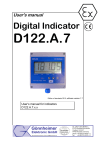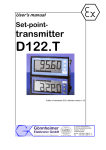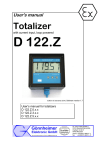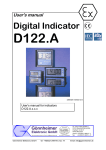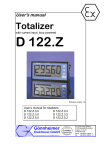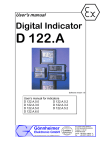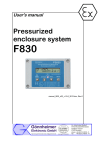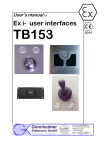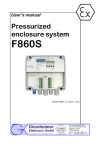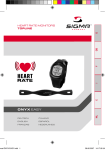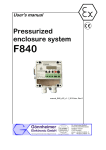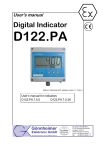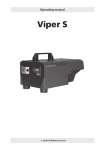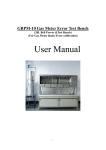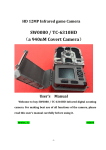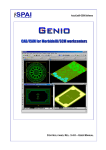Download manual_D122A V1.7_2010
Transcript
User's manual Digital Indicator D122.A Edition of standards 2010, software version 1.7 User’s manual for indicators D122.A.0.x.x D122.A.3.x.x D122.A.5.x.x D122.A.6.x.x D122.A 2 Operation instructions Page 2 Table of contents 1 Operation instruction for Explosion protected device ................................................................4 2 Digital Indicator D122.A ..................................................................................................................4 2.1 Short description ........................................................................................................................4 2.2 2.2.1 2.2.2 Features overview......................................................................................................................5 Basic functions ....................................................................................................................5 Options................................................................................................................................5 2.3 Conformity with Standards .........................................................................................................5 2.4 Internal zener barrier option .......................................................................................................6 2.5 Integrated 2-wire transmitter option ...........................................................................................6 2.6 Special software option ..............................................................................................................7 2.7 Curve fitting ................................................................................................................................7 2.8 Square root-fitting ......................................................................................................................7 3 Installation and Connection ...........................................................................................................8 3.1 3.1.1 3.1.2 D122 with control panel housing................................................................................................8 Installation control panel housing .......................................................................................8 Connecting D122 with control panel housing .....................................................................8 3.2 3.2.1 Field housing D122.A.5 and D122.A.6 ......................................................................................9 Connection D122 with field housing ...................................................................................9 3.3 Connecting D122A with zener barrier option ...........................................................................10 3.4 Connecting D122A with limit terminals (terminals 5/6 + 7/8) ...................................................11 3.5 3.5.1 3.5.2 Initial operation .........................................................................................................................11 Default parameters ...........................................................................................................11 Ex works settings – Device reset......................................................................................11 4 Operating manual ..........................................................................................................................12 4.1 Front view.................................................................................................................................12 4.2 Keyboard ..................................................................................................................................12 4.3 4.3.1 4.3.2 Configuration ............................................................................................................................13 How to set the parameters ...............................................................................................14 Hysterese and time delay setting .....................................................................................16 4.4 Configuration example .............................................................................................................17 5 Flow charts ....................................................................................................................................20 6 Annex .............................................................................................................................................26 6.1 Specifications ...........................................................................................................................26 6.2 Type code ................................................................................................................................27 6.3 Material specification ...............................................................................................................27 6.4 Marking ....................................................................................................................................27 6.5 Failure messages .....................................................................................................................28 6.6 Transport, Storing, Repairs und Disposal ................................................................................28 6.7 Dimensions ..............................................................................................................................29 6.8 List of Parameters ....................................................................................................................30 6.9 Index ........................................................................................................................................32 D122.A 2 Operation instructions Page 3 The symbols WARNING, CAUTION, NOTE This symbol warns of a serious hazard. Failure to observe this warning may result in death or the destruction of property. This symbol warns of a possible failure. Failure to observe this caution may result in the total failure of the device or the system or plant to which it is connected. This symbol highlights important information. D122.A 1 2 Operation instructions Page 4 Operation instruction for Explosion protected device Application and Standards This instruction manual applies to explosion-protected control panels of type of protection types below. This apparatus is only to be used as defined and meets requirements of EN 60 079 particularly EN60 079-14 "electrical apparatus for potentiality explosive atmospheres". Use this manual in hazardous locations, which are hazardous due to gases and vapours according to the explosion group and temperature class as stipulated on the type label. When installing and operating the explosion protected distribution and control panels you should observe the respective nationally valid regulations and requirements. General Instructions The device has to have a back-up fuse as stipulated. The mains connection must have a sufficient short circuit current to ensure safe breaking of the fuse. To achieve an impeccable and safety device operation, please take care for adept transportation, storage and mounting, as well as accurate service and maintenance. Operation of this device should only be implemented by authorised persons and in strict accordance with local safety standards. The electrical data on the type label and if applicable, the "special conditions" of the test certificate TÜV 99 ATEX 1488 are to be observed. For outdoor installation it is recommended to protect the explosion protected distribution and control panel against direct climatic influence, e.g. with a protective roof. The maximum ambient temperature is 40°C, if not stipulated otherwise. Intrinsically Safe Circuits Erection instructions in the testing certificates of intrinsically safe apparatus are to be observed. The electrical safety values stipulated on the type label must not be exceeded in the intrinsically safe circuit. When interconnecting intrinsically safe circuits it is to be tested, whether a voltage and/or current addition occurs. The intrinsic safety of interconnected circuits is to be ensured. (EN 60079-14, section 12) Safety Measures: to read and to comply Work on electrical installations and apparatus in operation is generally forbidden in hazardous locations, with the exception of intrinsically safe circuits. In special cases work can be done on non-intrinsically safe circuits, on the condition that during the duration of such work no explosive atmosphere exists. Only explosion protected certified measuring instruments may be used to ensure that the apparatus is voltage-free. Grounding and short-circuiting may only be carried out, if there is no explosion hazard at the grounding or short circuit connection. Danger of static charge! Clean only with humid cloth! Do not open when an explosive dust atmosphere is present! 2 Digital Indicator D122.A 2.1 Short description The digital Indicator D122 indicates measured values of intrinsically safe current circuits from 4 up to 20 mA in hazardous areas. The device is powered by measure current, therefore an extra power supply or batteries are unnecessary. The indicator measures the current, scales the measured value and displays finally the result on the LCD. D122.A 3 Installation and Connection Page 5 For trend analysis, the measured signal is also be displayed on a 41 segment bargraph. It's possible to scale the bargraph separately to the digital value. The indicator D122 is available in several housings. Furthermore with alarm monitoring option the indicator has two intrinsically safe alarm outputs. These outputs change their state, when the measured value exceeds his alarm limits. It’s possible to choose open-circuit or closed-circuit connection. Additional the alarm limits appear graphically on a second bargraph. On one look you’re sure that the measured value is in its limits. 2.2 Features overview 2.2.1 Basic functions • Loop-powered digital Indicator • Connect like passive analogue indicators, voltage drop ca. 1V • LC-Display up to 50 mm figure-height • Scale by buttons and display • Fast bargraph for trend observation (41 segments, refresh 4 times per second) • Separately scaleable Bargraph (Zoom) • Several housings available (control panel- and field housing) 2.2.2 Options • Alarm monitoring: two intrinsically safe alarm outputs and an additional limitbargraph on the display • Limit-functions with hysteresis and time delay • Field housing with additional (2nd) PG-Connector 2.3 Conformity with Standards The explosion proof indicators type D122 meets requirements of listed standards in the attachment (Declaration of conformity). They were developed, manufactured and tested in accordance with stateof-the-art engineering practice and ISO9001:2008. D122.A 2.4 3 Installation and Connection Page 6 Internal zener barrier option Devices with type code D122.A.x.x.BM The standard digital indicator D122 works exclusively in intrinsically safe 4..20 mA current circuits (Ex i). If the concerned measure current circuit is not intrinsically safe, an extra zener barrier or an isolated interface and a long additional cable to the interface outside the hazardous area and back is needed. In those cases, the option integrated zener barrier is very practical, because the interface is build in. A further advantage of an indicator with this option is that the intrinsical safety proof is not required. The ignition protection is Ex m [ib] IIC T6 at ambient temperature of 45°C, Ex m [ib] IIC T5 at 60 °C respectively. The terminal voltage in the measure circuit with internal zener barrier option is about 2 V. 2.5 Integrated 2-wire transmitter option Devices with type code D122.A.x.x.MU Using the integrated 2-wire transmitter for head mounting option, the D122 has an interface to an arbitrary sensor e.g. a PT 100. The digital indicator series with field housing can be equipped with a customized intrinsically safe 2wire transmitter for head mounting, according to DIN 43729 type B (max. height = 30 mm). With this option, it is possible to connect a sensor, e.g., a PT 100 directly to the digital indicator D122. Customer can specify or provide the desired transmitter by order. This option is only available for indicators with field housing. The depth of the field housing is increased from 64 to 82 mm. A combination with the internal zener barrier option is not possible. D122.A 2.6 3 Installation and Connection Page 7 Special software option Indicators D122.AS as well as totalizers D122.ZS have a special software option. With this option, it is possible to use these devices in any individual cases of measurement and indication. 2.7 Curve fitting The curve fitting software indicates the measure current in a non-linear way. Consider the application of a filling-level meter for a sphere-tank. The measure current is linear to the filling-height of the liquid. Nevertheless, the function between the filling-height and the volume is non-linear, as shown in the figure below. To get the correct quantity indication you require a list of points, which shows the connection between measure current and associated quantity inside of the tank. The curve fitting software of the D122.XS interpolates the curve between these points on your choice in a linear or a square way. The linear interpolation generates imaginary straight lines between the selected points. A value on this line will be calculated on base of his distance to the previous selected point. This kind of interpolation requires 17 points to scale 4 up to 20 mA. On the other hand, the square interpolation needs a list of 33 points, but it approximates the original curve much better than the linear one, so the error between the original curve and the interpolated curve is much smaller. To put in the list of selected point enter the (extended) scale menu. The device displays the measure current and you have to enter the associated display value. See also related flow diagram. 2.8 Square root-fitting To program a square root-function, e.g., to display the flow through a aperture, a special square rootfitting feature is available. For this option, it is not necessary to enter a list of points, but just a startand a end-value (in previous example: associated flow by 4 and by 20mA measure current). The device calculates automatically the selected points for interpolation. Be prepared, this procedure will take some time. See also related flow diagram. D122.A 3 Installation and Connection 3 Installation and Connection 3.1 D122 with control panel housing Page 8 3.1.1 Installation control panel housing The digital indicators D122.A.0 and D122.A.3 are predicated for installation in a control panel. How to insert the dimension symbol Insert the dimension symbol (icon) before mounting. Do this by first removing the front frame as shown in the figure at left. Now remove the front panel from the housing as shown in the figure on the right. Cut the desired dimension-symbol from the set and pull it into its intended place on the right side of the panel. Make sure that the symbol is facing the front. Replace the front panel and frame. Fixing Fix the indicator into the control panel with the intend cramps. 3.1.2 Connecting D122 with control panel housing Connect the indicator only to intrinsically safe 4..20 mA current circuits. The terminals of the indicators in the control panel housing are shown in figure 1. The terminals 5,6 and 7,8 are absent by indicators without alarm monitoring. Please regard the terminal maximum values of the attached EC- type certificate TÜV 99 ATEX 1488 . D122.A 3 Installation and Connection Intrinsically safe measure circuit 4 ..20 mA Terminals 1,2 Page 9 Alarm monitoring option terminals 5,6 low alarm terminals 7,8 high alarm Figure 1: Terminals by indicators with control panel housing 3.2 Field housing D122.A.5 and D122.A.6 When mounting the housing box on a wall, be sure that it is securely supported by anchoring the screws into a stud or other solid surface. How to insert the Dimensionsymbol First, cut the desired dimension symbol out of the set. Then pull off the four screws of the cap and remove the cap from the housing. Now push the prepared dimension-symbol into the dimension-symbol-slot. Make sure that the symbol is facing the front. The dimension-symbol-slot lies below the display, on the internal side of the cap. Finally replace the cup on the housing. 3.2.1 Connection D122 with field housing The terminals of the indicators with field housing are inside. The placement of the terminals is shown at the following figures. Figure 2 shows the terminals of the indicator D122.A.5. Figure 3 shows the terminals of the indicator D122.A.6. The terminals 5,6 and 7,8 are absent by indicators without alarm monitoring. Please regard the terminal maximum values of the attached EC- type certificate TÜV 99 ATEX 1488 . D122.A 3 Installation and Connection Page 10 Figure 2: Terminals of the indicator D122.A.5 Figure 3: Terminals of the indicator D122.A.6 3.3 Connecting D122A with zener barrier option Connect the D122.A.x.x.BM to a non intrinsically safe measure signal. Inside of hazardous area the D122A.x.x.BM cable must be connected in a certificated Ex e-connection box. Figure 4: Connection of D122.A.x.x.BM D122.A 3 Installation and Connection Cable colors 3.4 Cable Connection Brown + Blue - Green yellow PE Page 11 Connecting D122A with limit terminals (terminals 5/6 + 7/8) Devices with type code D122.x.x.2.x Figure 5 : limit monitoring with D122.x.x.2.x 3.5 Initial operation After connecting, a display test (all segments of the display are turned on) appears immediate during one second. Thereupon the display shows the software version of the indicator. 3.5.1 Default parameters The following parameters are active ex works: 4 mA curent -> 4.00 Scaling (display and bargraph) 20 mA current -> 20.00 Limits Low: 4.00 mA / High: 20.00 mA Hysteresis / Delay 0.10 / 0 sec. alarm outputs (alarm monitoring) circuit-opening connection Code words CODE1: 0001 / CODE2: 0002 3.5.2 Ex works settings – Device reset Press the Enter- and Right-button during the start sequence to reactivate the default parameters. (Hardware-Reset) A reset activates also the ex works calibration. D122.A 4 Manual 4 Operating manual 4.1 Front view 4.2 Keyboard Page 12 On the front side of the indicator are tree buttons with several function symbols. With these tree buttons, the user can activate each function and enter all parameters for any individual setting. The buttons are named by their functions: Enter-button Pressing the enter-button starts the input menu. In general, the enter-button activates the menu item or accepts the manipulated value of a parameter. Up-button Functions of the up-button are: 1. current control button 2. modification of the selected figure 3. pass menu items Right-button Functions of the right-button are: 1. change the display to limit view 2. select figures 3. pass menu items D122.A 4.3 4 Manual Page 13 Configuration It is easy to set the parameters and change the configuration of the indicator. The parameters are logically grouped by a menu structure. See also the appropriate flow diagram in the appendix. Indicators without the alarm monitoring option have not got the corresponding menu items. Note flow charts SET The Input views in the flow diagrams have additional boxes in their background, because the Input views may be changed by pressing any of the buttons. The procedure, to enter a value, is shown in the flow diagram ‘Value input menu’, see figure 13. ) Normal state After connecting, the indicator D122 starts to initialise its configuration. The configuration data is stored in an internal EEPROM due to the previous run. By the first start, the D122 indicator initialises the default configuration. Directly past starting sequence the indicator begins to display the measured current digital and analogous on the bargraph. This state is called the ‘normal state’ of the D122 and the indicator is also ready for inputs. (See also flow diagram in figure 9) ) current control Pressing and holding the up-button (current control button) the display shows the present current and the [mA] symbol. (See also flow diagram in figure 9) ) limit view menu (Only for indicators with the alarm monitoring option) One touch on the right-button starts the limit view menu. (See also flow diagram in figure 9) SET SET The display [limit low] appears on the screen. Press the enterbutton to watch the value of the lower limit. For passing the low limit press the right-button. The menu changes to the high limit. The screen shows now [limit high]. Confirm with the enter-button to display the value of the upper limit. Pressing the right-button for a second time quits the limit view menu and returns to normal state. During watching the limit values it is possible to manipulate them by pressing the enter-button. The view changes to the D122.A ; 4 Manual Page 14 Edit mode. A blinking segment appears below the sign place. Pressing the right-button selects the figure and the up-button increments the selected figure. To accept the new limit value, press the enterbutton. SET (See also flow diagram in figure 13) ; Code protection Max Before the menu gets to the edit mode the code 2 must be entered, to prevent a modification by unauthorised persons. Entering a wrong code word stops the limit view menu immediately. The default code 2 is [0002]. The interrogation of code 2 can be switched off by modifying the code 2 to [0000]. For this reason the flow diagram shows the code interrogation in stroked dots. 4.3.1 How to set the parameters ; (See also flow diagram in figure 11) Back in the normal state of the indicator we start the ) Input menu by pressing the enter-button. The configuration of the indicator is protected against manipulations by unauthorised persons with the code 1. To get the input menu enter the code 1 default [0001]. It’s impossible to switch off the code 1 interrogation. After entering the right code word the indicator proposes to join the Scale menu. The figure on the left hand appears on the screen. To scale the measured current, the bargraph and to set the decimal point join the scale menu by confirming with the enterbutton. See also flow diagram in figure 12). To pass the scale menu press the right-button. The following sub menu is called limit menu. This menu is naturally only available for indicators with the alarm monitoring option. In the limit menu the user enters the limits, as well as the hysteresis and the time delay of the alarm outputs. (See also flow diagram in figure 15) D122.A 4 Manual Page 15 The next two following items allow to manipulate the words for code 1 and code 2. The enter-button confirms the input and the corresponding code appears in edit mode. Remember that the code word [0000] switches off the code 2. Max Finally it’s possible to calibrate the indicator with the following sub menu called calibration menu. (See flow diagram in figure 16) The indicator is already calibrated ex-works. In general, a further calibration is not necessary and only experienced persons are allowed to calibrate it. False calibration will result senseless Indication. To start calibration enter the code word 01234. Now we reach the end of the input menu. Confirm the end with the enter-button. The indicator switches back to normal state. If you want to repeat the input menu, press the right-button. If an invalid value is entered for any of the parameters, you will not be able to quit the input menu. Instead, the program switches automatically into edit mode to the found valid value. D122.A 4 Manual Page 16 4.3.2 Hysterese and time delay setting Hysterese A hysteretic curve prevents an unwanted fast switching of the alarm outputs. alarm monitoring lower limit The switching behavior of the low alarm (min) shows figure 6. The switching behavior of the high alarm (max) shows figure 7. on off measured value lower limit Figure 6: Hysteric curve low alarm alarm monitoring upper limit hysteresis at upper limit on off measured value upper limit Figure 7: Hysteric curve high alarm Time delay The span of time ‘te’ is the difference between the first exceeding of the measurement above the upper limit and the switching of the high alarm (For the low alarm exists an analogous ‘te’). alarm monitoring upper limit time delay te on off time measured value upper limit time moment of first exceeding Figure 8: Time delay max respectively min Note If the measured current falls below the high limit during ‘te’, the tetimer resets. D122.A 4.4 4 Manual Page 17 Configuration example See the following example of a temperature measurement for a successful parameter input. o Situation • desired range: +10°C ... 20°C • sensor range: -20.0°C ... +30.0°C o Adjustment 1] Measure range: -20,00 °C ... + 30,00°C for 4 ... 20 mA 2] Bargraph: -5°C ... + 25°C 3] Limits: lower limit (min): +10°C upper limit (max.): +20°C 4] Hysterese: 0,5°C low and high limit 5] Alarm monitoring mode: circuit-opening connection 6] Time delay: 15 seconds Procedure: One touch on the enter-button quits the normal state and starts the input menu. The menu interrogates for code 1. The default code 1 is [0001]. Enter the right code word using the arrow buttons. Finally hit the enter-button. ; Scaling display and bargraph: Join the scale menu pressing the enter-button. SET First set the position of the decimal point. The position of the decimal point will be used for each parameter, like display, bargraph and limits. Set the decimal point position after the second position, because we will enter [2000] for the high scale point afterwards. Fortunately the default setting is on the desired position, so we can pass the item pressing the right-button. SET Now the [scale point low] view appears. Confirm by pressing the enter-button and enter the lower scale point (-20°C) as follows: D122.A 4 Manual Page 18 Choose the negative sign pressing the up-button. SET Touch the right-button to select the first figure. Now hit the up-button two times ... SET SET ... and the figure ‘2’ will be adjusted. SET Press the right-button to select the next figure. SET Hit the up-button until the figure ‘0’ appears. Confirm the lower scale point pressing the enter-button. Now the... SET ... item appears. Repeat the input procedure for the upper scale point like the lower scale point. Enter [3000] for the upper scale point. (Confirm by hitting enter-button) Enter the upper scale point correct figured ‘as big as possible’ (the first figures should not be ‘0’) In this case you get most precision of the indicator. Now scale the bargraph. Hit the enter-button. SET SET Enter [-0500] (-5°C) for the lower bargraph scale point. Confirm by hitting the enter-button Enter [2500] (25°C) for the upper bargraph scale point. Hitting enter-button accepts and quits the scale menu. ; Limits, Hysteretic curve and time delay Start limit menu by pressing the enter-button. SET Press the enter-button for a second time and enter [1000] (10°C) for the lower limit using the arrow buttons. Confirm by hitting the enter-button. (Remember, that the decimal point position is already set) D122.A 4 Manual SET SET SET SET Page 19 Press the enter-button and enter [2000] (20°C) for the upper limit. Confirm by hitting the enter-button. To select the hysteresis of the lower limit press the enterbutton. Now enter [0050] (0,5°C) using the arrow-buttons and confirm with the enter-button. To select the hysteresis of the upper limit press the enterbutton. Now enter [0050] (0,5°C) using the arrow-buttons and confirm with the enter-button. Now press enter-button to activate the time delay. Enter [0015] (15 seconds) for both limits. SET Confirm by hitting the enter-button. SET SET Now define the circuit-opening connection first for the low alarm limit. Choose the circuit-opening connection [nc---] (normal closed) using the up-button and confirm by pressing enter-button. Define the circuit-opening connection for the upper alarm monitor by the same procedure. Confirm by hitting the enter-button and quit the limit menu. We pass simply the following menu items (manipulate code words and calibrate) using the right-button. Finally quit the scale menu hitting the enter-button. The indicator is back in normal state. The changes are immediately active and will be stored after turn off (disconnecting the indicator). D122.A 5 5 Flow charts Page 20 Flow charts D 122.A START Limit view menu Min Max Input menu Normal state mA Min Max Current control view Figure 9: Flow diagram normal state Figure 10 Flow diagram limit view D122.A Input menu START 5 Flow charts Interrogate code 1 Page 21 false code word Ok SET Scale menu select scale menu SET Limit menu select limit menu SET select code 1 modify code 1 SET modify code 2 select code 2 SET Calibration menu select calibration menu quit input menu No Figure 11: Flow diagram input menu Yes Input menu END SET Figure 12: Flow diagram scale menu edit values enter code SET SET SET etc. sign is selected second figure is selected first figure is selected Menu END SET Menu END Menu END SET SET etc. sign is modified second figure is modified first figure is modified Menu END Menu END SET SET SET Menu END etc. first figure is modified sign is modified Menu END etc. second figure is modified Menu END etc. Figure 13: Flow diagram edit mode Menu END etc. Scale menu END edit bargraph high position select bargraph high position SET edit bargraph low position select bargraph low position SET edit high cale point (20 mA measure cur.) SET SET select high scale point SET edit low scale point (4 mA measure cur.) select low scale point SET select decimal point position SET Page 22 Scale menu START SET SET 5 Flow charts set position D122.A D122.A 5 Flow charts Alternative (extended) scale menu for special software option only Figure 14: Flow diagram extended scale menu Page 23 D122.A Figure 15: Flow diagram limit menu 5 Flow charts Page 24 D122.A 5 Flow charts Calibration menu START Interrogate code Ok SET calibration pass 1 SET 4 mA order 4 mA input current SET calibration pass 2 SET 20 mA order 20 mA input current SET calibration pass 3 Calibration menu END Figure 16: Flow diagram calibration menu Page 25 false code word D122.A 6 Annex 6 Annex 6.1 Specifications Page 26 D122 D122.A.0 D122.A.3 Display Digit height D122.A.5 4½ -digit seven-segment LCD 15mm 30mm Display range 3½-digits 30mm 50mm -19999 ... +19999 -1999 ... +1999 Dimension symbols Selectable with defined symbols Decimal points Selectable by keyboard Bargraph 41 segments / Alarm limits display - Via bargraph Versions D122.A..2 - Flashing ‘max.’ or ‘min’ display Alarm limit monitoring D122.A.6 By means of intrinsically safe control circuits (e.g. NAMUR or DIN 19234) Version D122.A..2 Current control button Direct display of current in measurement circuit Measurement circuit Intrinsically safe measurement circuit 4 ...20 mA; Voltage drop ca. 1V Measurement circuit limits No-load Voltage Ui ≤ 65 V; short-circuit current Ik ≤ 160 mA Internal inductance: ≤ 40 μH; Internal capacitance: ≤ 10 nF, see certificate TÜV 99 ATEX 1488 Limits with zener barrier option UM = 250 V see certificate TÜV 99 ATEX 1488 Alarm monitoring limits By intrinsically safe control circuits No-load Voltage Ui ≤ 30 V; Short-circuit current Ii ≤ 160 mA Pmax not greater than 850 mW; Internal inductance: ≤ 40 μH Internal capacitance is negligible, see certificate TÜV 99 ATEX 1488 Explosion protection Ex ib IIC T6 Gb at ambient temperature 45°C or Ex ib IIC T5 Gb at ambient temperature 60°C Housing Acc. to control-panel standard DIN 43700 - Protection class Front panel 40 up to IP 65 IP 65 Dimensions HxWxD [mm] Material 48x96x62 72x144x80 134x138x64 glass fibre strengthened Noryl 138x184x64 ABS Measuring error 0,1% ± 2 digits referring to measure range Temperature < 0,01% of measure range / K coefficient Ambient temperature limit -10°C ...+45°C for temperature class 6 or -10°C ...+60°C for temperature class 5 Indicators for -20°C ambient temperature on inquiry D122.A 6.2 6 Annex Page 27 Type code Device series D122 . . Device: Indicator .................................................................. .A Indicator with curve fitting option ................................ .AS Totalizer ..................................................................... .Z Totalizer with curve fitting option ................................ .ZS Housing: Control panel housing 48 x 96 mm ......................... .0 Control panel housing 72 x 144 mm ...................... .3 Field housing (30 mm figure height) ...................... .5 Field housing (50 mm figure height) ....................... .6 Digital output: without ................................................................ with 2 digital outputs ........................................... with reset input and pulse output ........................ Additional option: . .0 .2 .3 Internal zener barrier1 .................................................................................... .BM Internal two wire readings recorder² .............................................................. .MU 1: Not suitable for D122.x.0.x.x 2: For flied housings only, a combination with internal zener barrier (.BM) is not possible 6.3 Material specification Device type Material manufacturing process D122.x.0.x.x D122.x.3.x.x D122.x.5.x.x D122.x.6.x.x D122.x.7.x.x Noryl Noryl ABS ABS Aluminum injection die injection die injection die injection die die-casting 6.4 casting casting casting casting Marking Marking according to 50014 ff Marking according to EN 60079 :2010 D122.x.x.x.0 D122.x.x.x.MU II 2 G; EEx ia IIC T6 bei Ta bis 45°C II 2 G; EEx ia IIC T5 bei Ta bis 60°C II 2 G; Ex ia IIC T6 Gb bei Ta bis 45°C II 2 G; Ex ia IIC T5 Gb bei Ta bis 60°C D122.x.x.x.BM II 2 G; EEx ia [ib] IIC T6 bei Ta < 45°C II 2 G; EEx ia [ib] IIC T5 bei Ta < 60°C II 2 G; Ex ia [ib] IIC T6 Gb bei Ta < 45°C II 2 G; Ex ia [ib] IIC T5 Gb bei Ta < 60°C 0044 D122.A 6.5 6 Annex Page 28 Failure messages At startup: Message Symptom Bug-fix Error 1 Error, general device fault Turn off an turn on the device, if the fault remains, send the device back to Gönnheimer 6.6 Transport, Storing, Repairs und Disposal Transport Vibration-free in origin package, do not pitch, handle carefully Storing Store the device dry, inside of the origin package Disposal When the explosion proof multipurpose distribution, switching and control units are eventually disposed of, the national regulations governing the disposal of waste materials in the country concerned must be rigorously observed. Defective parts may only be replaced by the Manufacturer or by personnel specially trained and supervised by the Manufacturer. Only genuine spare parts from the Manufacturer may be fitted. Repairs D122.A 6.7 6 Annex Dimensions Figure 17: Control panel housing Figure 18: Field housing Figure 19: Field housing Page 29 D122.A 6.8 6 Annex Page 30 List of Parameters The customer is free to use this chart for archiving the parameters of his indicator D122. Parameter Description Previous Display Value Scale menu Decimalpoint position dP.PoS Low scale point Display at 4 mA input current SCAL L High scale point Display at 20 mA input current SCAL H Bargraph low position Display at starting bargraph bAr L Bargraph high position Display at full bargraph bAr H 0000 Limit menu Low limit LI L High limit LI H Hysteresis of low limit HYS L Hysteresis of high limit HYS H Alarm connection of low limit Choice between normal open (no) and normal closed (nc) Con L nc no Alarm connection of high limit Choice between normal open (no) and normal closed (nc) Con H nc no Code word Nr. 1 CodE 1 Code word Nr. 2 CodE 2 Only on Option Sondersoftware Low scale point root function Display at 4 mA input current roo L High scale point root function Display at 20 mA input current roo H D122.A 6 Annex Page 31 Linear resp. square Interpolation Choice between linear or square Interpolation Setpoint INTER 400 450 500 550 600 650 700 750 800 850 900 950 1000 1050 1100 1150 1200 1250 1300 1350 1400 1450 1500 1550 1600 1650 1700 1800 1850 1900 1950 2000 In 33 In17 D122.A 6.9 6 Annex Index hysteresis 5, 11, 14, 17 A alarm limit monitoring 26 C closed-circuit connection 5, 17 code protection 14 configuration 13 current control 13 current control button 12 L limit high 13 limit view menu 13 lower scale point 17 N NAMUR 26 Noryl 26 D P decimal point 17 dimension symbol 9 parameter entering 14 precision 18 E T ex works 11 temperature 26 time delay 16 H hardware-reset 11 Page 32 Non authorized translation (1) EC- TYPE- EXAMINATION CERTIFICATE (Translation) (2) Equipment and protective systems intended for use in potential explosive Atmospheres – Directive 94/9/EC (3) EC- type- examination Certificate number TÜV 99 ATEX 1488 (4) Equipment: Digital Indicator Type D122... (5) Manufacturer: Gönnheimer Elektronic GmbH (6) Address: D-Neustadt an der Weinstraße (7) This equipment and any acceptable variation thereto are specified in the schedule to this certificate and the documents therein referred to. (8) The TÜV Hannover/Sachen-Anhalt e.V., TÜV CERT-Zertifizierungsstelle, notified body No. 0032 in accordance with Article 9 of the Council Directive 94/9/EC of March 1994, certifies that equipment has been found to comply with the Essential Health and Safety Requirements relating to the design and construction of equipment and protective systems intended for use potentially explosive atmospheres, given in Annex II to the Directive. The examination and test results are recorded in the confidential report No. 99/PX24090 (9) Compliance with to essential Health and Safety Requirements has been assured by compliance with: EN 50 014:1997 EN 50 020:1994 EN 50 028:1988 (10) If the sign “X” is places after the certificate number, it indicates that the equipment is subject to special conditions for safe use specified in the schedule to this certificate. (11) This EC- type- examination Certificate relates only to the design and construction of the specified equipment in accordance with Directive 94/9/EC. Further requirements of this Directive apply to the manufacture and supply of this equipment. (12) The marking of the equipment shall include the following: II 2 (1) G EEx ia IIC T6 bzw. EEx m [ib] IIC T6 TÜV Hannover/Sachen-Anhalt e.V. TÜV CERT-Zertifizierungstelle Am TÜV 1 D-30519 Hannover Hannover, 02.11.1999 Der Leiter EC-type-examination Certificates without signature and official stamp shall not be valid. The certificates may be circulated only without alteration. Extracts or alterations are subject to approval by the TÜV Hannover/Sachsen-Anhalt e.V. Page 1 of 8 Non authorized translation (13) SCHEDULE (14) (15) EC- TYPE-Examination CERTIFICATE No. TÜV 99 ATEX 1488 Description of equipment The digital indicator type D122 ... serves as direct indicator of measured values of intrinsically safe 4 ..20 mA current circuits in explosive endangered areas. The maximum ambient temperature is 45°C in temperature class T6 and 60°C in the temperature class T5. Electrical details Supply and signal current circuit (Terminal 1,2) Exclusive connection to a certificated intrinsically safe current circuit with the following highest values: Ui = 65 V Ii = 160 mA Effective internal inductivity 40 µH Effective internal capacity 10 nF Only Type D122.T.x.x.x Supply and signal current circuit (Terminal 1,2) Exclusive connection to a certificated intrinsically safe current circuit with the following highest values: Ui = 30 V Ii = 160 mA Pi = 1,6 W Effective internal inductivity 40 µH effective internal capacity 10 nF Terminals 3,4 Bridget Only TYP 122.x.x.x.BM with additional protection type moulding and the sign EEx m [ib] IIC T6 bzw. EEx m [ib] IIC T5 Input current circuit (wire) Um = 250 V and to connect to ground EC-type-examination Certificates without signature and official stamp shall not be valid. The certificates may be circulated only without alteration. Extracts or alterations are subject to approval by the TÜV Hannover/Sachsen-Anhalt e.V. Page 2 of 8 Non authorized translation Schedule EC- Type- Examination Certificate No. TÜV 99 ATEX 1488 Any types Alarm current circuits (Terminal 5,6; 7,8) Outputs: Inputs: Exclusive connection to a certificated intrinsically current circuit with the following highest values each current circuit: Ui = 30 V Ii = 160 mA Pi = 850 mW Ui = 30 V Effective internal inductivity ≤ 40 µH the effective internal capacity is negligibly small All current circuits are safe gavanically separated up to a nominal voltage of 90 V to each other. The input current circuit by the type D122.x.x.x.BM is internally connected to the supply and signal circuit. (16) Report No. 99/PX24090 (17) Special conditions for safe area None (18) Essential health and safety requirements No additional EC-type-examination Certificates without signature and official stamp shall not be valid. The certificates may be circulated only without alteration. Extracts or alterations are subject to approval by the TÜV Hannover/Sachsen-Anhalt e.V. Page 3 of 8 Non authorized translation 1. Amendment to the Conformity Certificate Nr. TÜV 99 ATEX 1488 Manufacturer: Gönnheimer Elektronic GmbH Dr.-Julius Leber-Str.2 D-67433 Neuststadt/Weinstraße The digital indicator type D122 can also be manufactured according to the examination protocol, listed in the associated examination certificate. The changes concern the enlargement around the type D122.x.7.x.x. and the application of type in explosion areas by dust up to ambient temperatures of 65°C. The marking for it is: II 2 D IP 65 T70°C Bases of the standards: EN 50281 1 1:1999 The electric data and all other information are valid consistently for this supplement. The test documentation is listed in test report Nr. 04YEX551218 TÜV NORD CERT GmbH & Co. KG Hannover, 17.02.2004 TÜV CERT-Zertifizierungsstelle Am TÜV 1 0-30519 Hannover Tel.: 0511 986-1470 Fax: 0511 986-2555 Der Leiter EC-type-examination Certificates without signature and official stamp shall not be valid. The certificates may be circulated only without alteration. Extracts or alterations are subject to approval by the TÜV Hannover/Sachsen-Anhalt e.V. Page 4 of 8 Non authorized translation 2. Amendment to the Conformity Certificate Nr. TÜV 99 ATEX 1488 Manufacturer: Gönnheimer Elektronic GmbH Dr.-Julius Leber-Str.2 D-67433 Neuststadt/Weinstraße The digital indicator type D122 can also be manufactured according to the examination protocol, listed in the associated examination certificate. The change concerns the enlargement around the types D122.PA.7.0.0 and D122.FF.7.0.0 for the binding to intrinsically safe field busses Profibus PA respectively FF.H1. The application of the supplemental types can occur in explosion-threatened areas, Which requires devices of the category 2. By the application in areas of explosion-threatened by dust, the at most allowed ambient temperature is +65°C. By the application in areas explosion-threatened by gas is the maximum ambient temperature depending on the temperature class according to the following table: Temperature classe T6 T5 Ta Up to 45°C Up to 60°C Electrical data of the types D122.PA.7.0.0 and D122.FF.7.0.0 Signal and power supply circuit Ex- protection Intrinsically safe EEx ia IIC (terminal 1,3 and 2,4) only to the connection in certified intrinsically safe circuits. Maximum ratings: U0 = 30 V I0 = 660 mA P0 = 1,6 W max reactances L0 = 0 µH C0 = 0 nF The electrical data remains unchanged. EC-type-examination Certificates without signature and official stamp shall not be valid. The certificates may be circulated only without alteration. Extracts or alterations are subject to approval by the TÜV Hannover/Sachsen-Anhalt e.V. Page 5 of 8 Non authorized translation 2. Amendment to the Conformity Certificate Nr. TÜV 99 ATEX 1488 The marking of the equipment: II 2 (1) G EEx ia IIC T6 or T5; resp. II 2 D IP65 T70°C The marking of the further types remain unchanged. The digital indicator type D122... according to the EC-type certificate TÜV 99 ATEX 1488 incl. 1. and this 2nd supplement also fulfils the demands of EN 50 014 :1997 + A1+A2 EN 50 020:2002 EN 50 281-1-1:1998+A1 General directives Intrinsically safe “i” Electrical devices with protection by case construction and check All remaining data remain unchanged for this 2. Amendment. The test documentation is listed in test report Nr. 04YEX551692 TÜV NORD CERT GmbH & Co. KG Hannover, 03.11.2004 TÜV CERT-Zertifizierungsstelle Am TÜV 1 0-30519 Hannover Tel.: 0511 986-1470 Fax: 0511 986-2555 Der Leiter EC-type-examination Certificates without signature and official stamp shall not be valid. The certificates may be circulated only without alteration. Extracts or alterations are subject to approval by the TÜV Hannover/Sachsen-Anhalt e.V. Page 6 of 8 Non authorized translation 3. Amendment to certification number: TÜV 99 ATEX 1488 Device: Manufacturer: Digital indicator type D122… Gönnheimer Elektronic GmbH Dr.-Julius Leber-Str.2 D-67433 Neuststadt/Weinstraße Germany 8000553381 10.10.2006 Address: Order Number: Date of issue: Changes: The digital indicator type D122 can also be manufactured according to the examination protocol, listed in the associated examination certificate. The change concerns the enlargement around the types D122.PA.7.0.3K and D122.FF.7.0.3K for the binding to intrinsically safe field busses Profibus PA respectively FF.H1 as a three channel indicator. The application of the supplemental types can occur in explosion-threatened areas, which requires devices of the category 2. By the application in areas of explosion-threatened by dust, the at most allowed ambient temperature is +65°C. The information to the allowed ambient temperature is valid consistently accordingly of the second supplement also for the supplemental types. The electric data of the second supplement are changed as follows or complemented: Electric data of the types D122. PA.7.0.0, D122.FF 7.0.0, D122. PA.7.0.3K and D122.FF.7.0.3K: Signal and power supply circuit (terminal 1,3 and 2,4) By the application in by gas explosionthreatened areas in Ex protection Intrinsically safe EEx ia IIC. Field device FISCO to the connection with a device according to the FISCO model or Only to the connection in certified intrinsically safe circuits. Maximum ratings: U0 = 30 V I0 = 660 mA max reactances L0 = 0 µH C0 = 0 nF By the application in by dust explosionthreatened areas max. limit input power P0 = 1,6 W The electrical data remains unchanged. EC-type-examination Certificates without signature and official stamp shall not be valid. The certificates may be circulated only without alteration. Extracts or alterations are subject to approval by the TÜV Hannover/Sachsen-Anhalt e.V. Page 7 of 8 Non authorized translation 3. Amendment to the Conformity Certificate Nr. TÜV 99 ATEX 1488 The marking of the equipment: II 2 (1) G EEx ia IIC T6 or T5; resp. II 2 D IP65 T70°C The marking of the further types remain unchanged. The digital indicator type D122... according to the EC-type certificate TÜV 99 ATEX 1488 incl. 1. and this 2nd supplement also fulfils the demands of EN 50 014 :1997 + A1+A2 EN 50 020:2002 EN 50 281-1-1:1998+A1 DIN EN 60079-27:2006 General directives Intrinsically safe “i” Electrical devices with protection by case construction and check Concept for intrinsically safe field bus systems (FISCO) and concept for non sparking field bus systems (FNICO) The test documentation is listed in test report Nr. 06 YEX 553381. (17) Special conditions for safe area None (18) Essential health and safety requirements No additional TÜV NORD CERT GmbH, Langemarckstraße 20, 45141 Essen, akkreditiert durch die Zentralstelle der Länder für Sicherheitstechnik (ZLS), Ident. Nr. 0044, Rechtsnachfolger der TÜV NORD CERT GmbH & Co. KG Ident. Nr. 0032 Der Leiter der Zertifizierungstelle Schwedt Geschäftsstelle Hannover, Am TÜV 1, 30519 Hannover, Tel.: +49 (0) 511 986-1455, Fax: +49 (0) 511 986-1590 EC-type-examination Certificates without signature and official stamp shall not be valid. The certificates may be circulated only without alteration. Extracts or alterations are subject to approval by the TÜV Hannover/Sachsen-Anhalt e.V. Page 8 of 8 EG-Konformitätserklärung Declaration of conformity / Déclaration de conformité Communauté Européenne Anbieter: Supplier: Fournisseur Gönnheimer Elektronic GmbH Anschrift: Address: Adresse: Gewerbegebiet Nachtweide Dr.-Julius-Leber-Straße 2 67433 Neustadt/Weinstraße Produkt: Product: Produit: D122, Anzeigegerät /Zähler Das oben beschriebene Produkt erfüllt die Schutzanforderungen der folgenden EG-Richtlinien / the product described above complies with the following EG- rules / le produit décrit cidessus accomplit CU- réglementations 2004/108/EG, 93/68/EWG, 94/9/EG und ist konform mit / and is in conformity with / et est conforme á: EN 60079-0: 2009, Allgemeine Bestimmungen EN 60079-11: 2007, Eigensicherheit „i“ EN 60079-18: 2004, Vergusskapselung „m“ EN 61241-1:2004, Schutz durch Gehäuse "tD" EN 60079-27:2008, Feldbussystme FISCO + FNICO EN 1127-1: 2008, ATEX- Grundnorm EN 61000-6-4: Fachgrundnorm Störaussendung; Teil 6-4: Industriebereich EN 61000-6-2: Fachgrundnorm Störfestigkeit; Teil 6-2: Industriebereich EN 60947-1: 2008, Niederspannungs-Schaltgeräte zusätzliche Angaben / additional information / informations supplémentaires: Qualitätsmanagement- System nach ISO EN DIN 9001:2008 Anerkanntes Qualitätssicherungssystem nach Richtlinie 94/9/EG EG- Baumusterprüfbescheinigung / EC- Type certification / Attestation d’examen ce de type TÜV 99 ATEX 1488 Neustadt, den 11.03.2010 Gönnheimer Elektronic GmbH EG-Konformitätserklärung; Rev.1









































